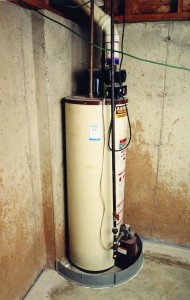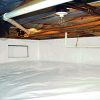
In addition to improving efficiency, maintaining your tank will likely make it last longer, too. The burner will not have to fire as long or as often to reach the desired water temperature.
Summer is a good time to improve the efficiency of a conventional gas-fired tank-type hot water heater (the kind most of us have). Why summer? Because it’s a wet job that won’t be a lot of fun when the temperatures drop!
Water heater tanks often collect sediment (mostly minerals in the water supply) at their base. After several years, it can build up to the point where it will reduce the heat conductivity between the gas burner under the tank and the water you’re trying to heat. To remove sediment, you must completely empty the tank.
Before draining and refilling your tank, check the pressure relief valve to be sure it’s still working. This valve protects you in the event of a thermostat failure by automatically releasing pressure buildup and preventing the tank from bursting. To check it, turn the gas switch to “pilot” (this keeps the pilot light on but stops gas flow to the burner). Then turn off the cold water supply line valve. Place a bucket under the overflow tube, trip the lever on the valve, and listen for a release of air or water. If there is none, you will need to replace the pressure release valve. Wait to replace it until after you have after you have refilled your tank.
Next, run a long garden hose from the drain valve to the outside. If your tank is below grade (in a basement), you’ll need two lengths of hose, one that runs from the tank to a small, portable pump – and the other from the pump to the outside. Otherwise, gravity will suffice. Do not drain sediment into a floor drain or utility sink, or else you will simply create a new problem. To be safe, allow the water in the tank to cool for several hours before opening the drain valve.
Open all hot water faucets in the house so the tank will drain freely. Then open the drain valve. Switch on the pump if you’re using one. Allow the tank to drain completely. Then intermittently turn on the water supply. Short bursts of water may help dislodge any remaining sediment. If accumulated sediment slows the flow from the drain valve – or clogs it — it may be necessary to remove the valve from the tank so you can flush sediment through the larger opening. With the valve removed, a long screwdriver or dowel may be used to help dislodge the sediment. If you’re not using a pump, have several large basins on hand so you can shuttle water outside or to a utility sink as it drains.
Once the water runs clear, turn off the supply. Then close the drain valve, and turn on the cold-water inlet to the tank. Close the hot-water faucets, and turn your water heater on.
Plumbing fittings can be stubborn and/or fragile. If you are unsure about your skills or do not possess the necessary tools, hire a licensed plumber to do the job – especially if you find that your pressure release valve is no longer working. In addition to improving efficiency, maintaining your tank will likely make it last longer, too. The burner will not have to fire as long or as often to reach the desired water temperature.




